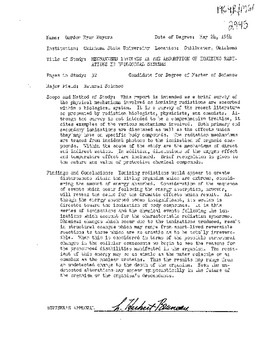| dc.contributor.advisor | Bruneau, L. Herbert | |
| dc.contributor.author | Meyers, Gordon Ryan | |
| dc.date.accessioned | 2016-02-24T21:37:44Z | |
| dc.date.available | 2016-02-24T21:37:44Z | |
| dc.date.issued | 1964-05 | |
| dc.identifier.uri | https://hdl.handle.net/11244/31619 | |
| dc.description.abstract | Scope and Method of Study: This report is intended as a brief survey of the physical mechanisms involved as ionizing radiations are absorbed within a biological system. It is a survey of the recent literature as presented by radiation biologists, physicists, and chemists. Although the survey is not intended to be a comprehensive treatise, it cites examples of the various mechanisms involved. Both primary and secondary ionizations are discussed as well as the effects which they may have on specific body compounds. The radiation mechanisms are traced from incident photons to the ionization of organic compounds. Within the scope of the study are the mechanisms of direct and indirect action. ln addition, discussions of the oxygen effect and temperature effect are included. Brief recognition is given to the nature and value of protective chemical compounds. | |
| dc.description.abstract | Findings and Conclusions: Ionizing radiations would appear to create disturbances within the living organism which are extreme, considering the amount of energy absorbed. Consideration of the sequence of events which occur following the energy absorption, however, will reveal the cause for the dramatic effects which result. Although the energy absorbed seems insignificant, its action is directed toward the ionization of body compounds. It is this series of ionizations and the chemical events following the ionizations which account for the characteristic radiation syndrome. Chemical changes which occur due to the ionizations produced, result in structural changes which may range from short-lived reversible reactions to those which are so drastic as to be totally irreversible. When this is considered in terms of the possible structural changes in the cellular components we begin to see the reasons for the pronounced disabilities manifested in the organism. The recipient of this energy may be as simple as the water molecule or as complex as the nuclear proteins. Thus the results may range from an undetected change to the death of the organism. Even the undetected alterations may appear symptomatically in the future of the organism or the organism's descendants. | |
| dc.format | application/pdf | |
| dc.language | en_US | |
| dc.rights | Copyright is held by the author who has granted the Oklahoma State University Library the non-exclusive right to share this material in its institutional repository. Contact Digital Library Services at lib-dls@okstate.edu or 405-744-9161 for the permission policy on the use, reproduction or distribution of this material. | |
| dc.title | Mechanisms involved in the absorption of ionizing radiations in biological systems | |
| dc.contributor.committeeMember | Fite, Robert C. | |
| osu.filename | Thesis-1964R-M613m.pdf | |
| osu.accesstype | Open Access | |
| dc.type.genre | Master's Report | |
| dc.type.material | Text | |
| thesis.degree.discipline | Natural Science | |
| thesis.degree.grantor | Oklahoma State University | |
